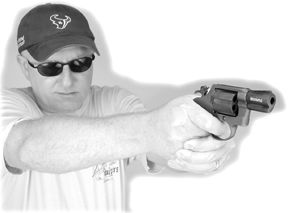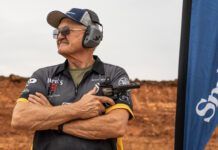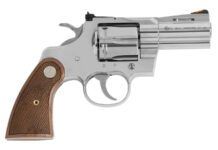
Perhaps the loudest noise in the lightweight revolver boom was Smith & Wesson’s five-shot 342Ti, which was constructed with titanium components. This snub-nosed revolver was reviewed in the March 1999 issue of Gun Tests and performed at the top of the list against rivals such as the Ruger SP101, two revolvers from Taurus, and Smith & Wesson’s own 642, another Centennial model featuring a fully enclosed hammer system. The 342Ti’s strong point was that it was so light it could actually be forgotten in a coat pocket. Its weak point was that it was shipped with a beautiful wood grip that could tear your hand to shreds in short order. The original model 342Ti sold for just $499, and adding rubber grips made the titanium gun easier to shoot.
In the September 2000 issue, we tested an upgrade of the 342Ti—the 342PD—that cost nearly $300 more. We liked the PD’s performance as well, our only caveat being its price. In our continuing and selfless efforts to find the best mix of price and performance, we recently chose two more affordable guns to put up against the expensive PD, both to double-check our original judgment and also to keep an eye on Smith & Wesson’s quality as it wades through troubled times. Our alloy-framed test guns were Colt’s classic $339 Agent, Smith & Wesson’s newly slimmed-down Bodyguard, $492, and a fresh high-tech/high-dollar 342PD, $759.
The object of lightweight snubbies is to afford an effective level of firepower in a package that is reliable, simple to operate, and easy to carry. The two revolvers we previously hadn’t tested are retro in design. The Bodyguard has been around for ages it would seem, and was one of the earliest successful attempts at taking the inevitable snagging of clothing by the hammer out of the equation. The Colt Agent is an alloy version of the Colt Detective that incorporates the leaf spring action of the Python. It is larger than the Smith & Wesson J-frames but carries a sixth shot without creating an inordinately larger profile or enough extra weight to sag one’s belt. Although currently out of production, there seems to be some Colt Agents available, and we found it so fascinating we were bound to consider it a legitimate player in the current lightweight race.
Range Session
In two past evaluations of ultra-lightweight snubbies, we recorded accuracy data from both 10 and 15 yards. Checking those results, it is apparent that 15 yards is much more challenging for these short guns. In our September 2000 test, nearly all five revolvers were able to record sub 1-inch groups with three different cartridges from ten yards. In March 1999, only the Smith & Wesson 342Ti managed a sub 1-inch group at 15 yards. This was accomplished with Federal’s 130-grain full metal jacketed round.
For our latest test we felt we should explore the viability of more unusual ammunition. This was spurred by the knowledge that titanium revolvers are recommended for use with jacketed rounds. In fact, the 342-series revolvers come with a printed warning saying not to use lead bullets. Although no reference to bullet weight is made with the current warning, we distinctly remember the manufacturer also recommending bullets weighing 125 grains or less. Reason: A super-light revolver is prone to recoiling backward so quickly it may actually leave the bullet behind. If the bullet is too heavy and/or the crimp is trying to hold soft lead, the case may accelerate to the rear so fast that the slug pulls loose slightly, possibly protruding far enough to meet the forcing cone and jam the gun. Thus, the heaviest round we chose for this test was a classic 125-grain +P cartridge from Black Hills. We found 110-grain Silvertip Hollow Points from Winchester and quickly added them to our test roster. MagSafe produces a frangible hollow point that was designed for airweight revolvers called the Defender. These 52-grain cartridges produced 1,620 fps and 303 foot-pounds of muzzle energy from a 3-inch Ruger SP101. We wondered how they would fare in this trio.
[PDFCAP(1)].To get started, we oiled our test guns sparingly and fed them a variety of standard .38 Special rounds, shooting at least 100 break-in shots per gun. From there, we shot the guns off a simple sandbag rest at a black 5.5-inch bullseye 15 yards downrange, along with various handling comparisons. Here’s what we found:
Smith & Wesson Centennial 342PD, $759
The great value of the Centennial series is its fully enclosed ignition system—that is, no exposed hammer. As a result, the Centennial-series revolvers are double action only, but the trigger movement is very long. In fact, the shooter has the choice of staging the trigger or pulling straight through. We found the 342PD’s trigger to be easy to stage by placing our finger all the way across the trigger and curling the tip to the rear so that the hammer sequence would stop when our finger touched the frame. This created a de-facto single-action press.
Nevertheless, we felt accuracy from the PD was slightly sub-par. We can attribute this to a number of factors. For one, the trigger-pull weight felt the heaviest of our test guns at 14 pounds. Next, the angle at which your finger concludes its press was too far rearward. The edge of the trigger dug in and eventually cut our trigger fingers. A common refinement like rounding off the trigger shoe is not too much to ask of a $759 snubby, in our opinion.
The only tangible difference between the $699 342Ti and the PD that we saw was a different color and the addition of an orange insert at the front sight. The front sight may also be too wide, but either way we feel this upgrade is not complete without addressing the rear portion of the sight picture as well.
Cylinder and Slide, (800) 448-1713, is currently marketing a low-profile fixed sight that resembles the (Wayne) Novak system for K- and L-frame revolvers (part number CS123 $79.95, or CS123D with dot for $89.95). A similar upgrade for this gun would be a real plus, even if the J-frame revolvers are meant primarily for short-distance work.
Elsewhere, we have to wonder how light is too light for a carry gun. In our first test of the 342Ti, we actually misplaced the gun in a coat pocket. Can you forget you have it with you? While conducting our tests at a public range, one interested bystander asked to handle the 342PD and volunteered an interesting point: “If my kid found this gun, it is so light he would mistake it for a toy.” Hopefully, his child is better trained than that, but at a weight of somewhere between 12.9 and 13 ounces, the gun is surprisingly lightweight. To see how light, we purchased a plastic water gun at a local supermarket and filled the toy replica (similar in size to the J-frame) with water. The toy weighed more than 9 ounces, only 4 ounces less than the PD.
The 342PD’s feather-like weight is mostly the product of using a titanium cylinder. The cylinder is usually made of steel, for it suffers the most stress. Other titanium parts include the struts, which show as lighter-colored dots against the matte-black alloy frame. These parts largely account for the differences in weight between the 342PD and the 638 Bodyguard, which has many aluminum alloy parts.
At the range, we learned our choice of ammunition may have hurt the PD more than the other guns. Fixed-sight guns without mechanical adjustment for windage or elevation must be matched to the proper ammunition to assure accuracy. Bullet weight is a key element in proper elevation. Groups printed by both Smith & Wesson revolvers were decidedly low, and the Black Hills 125-grain JHP +P rounds shot fairly big 3-inch groups. But the MagSafe 52-grain Defender shot much more poorly. We asked ourselves if this was the fault of the gun or if there was a problem with the ammunition. For a control we fired a group of Defender rounds from a Smith & Wesson 686 with a 2.5-inch barrel. In rapid- fire fashion, we reeled off a 1.4-inch group with this very same lot of MagSafe ammunition. We later found that the Colt Agent would also shoot the frangible round satisfactorily. Perhaps a more traditional bullet weight (158 grains) would have improved the performance of this revolver.
Smith & Wesson 638 Bodyguard, $492
The name Bodyguard has to be one of the all-time classic names for a self-defense gun. Certainly this Smith & Wesson design has been with us a long time, and in many ways it should be considered an unsung hero among the latest super-light firearms, mainly because it did so much so well.
The 638 Bodyguard was the happiest gun in this test. It didn’t seem to care about bullet weight or configuration, and firing DA or SA it was our accuracy winner. Results firing the frangible MagSafe were acceptable, but the Winchester Silvertips were better still. The top shooter was the Black Hills 125-grain JHP +P rounds, and we feel this old-fashioned gun style would really shine with a 158-grain round.
In our view, three key points made this revolver superior to the 342PD. Up front was a narrow front blade that takes full advantage of the limited sight channel dug into the top strap. This blade had a serrated ramp to kill glare, and a deeper-cut notch clearly defined its maximum sight radius.
The next element was a trigger that can be fired double or single action. The single-action trigger on this very small gun was better than what we typically find on most full-sized revolvers. The trigger face itself was properly radiused and a pleasure to touch. We had to check twice to make sure our measurements were correct, but both the 342PD and the Bodyguard offered 14-pound trigger pulls. The difference must be in the exposed hammer. Perhaps once you’ve got the hammer going, its momentum makes the trigger pull feel lighter. Ignition on this latest edition of the Bodyguard is by a flat-faced hammer striking an inertial firing pin riding spring-loaded inside the frame. The firing pin on the original model, often referred to as a nose-pin, rode on the hammer itself. We compared DA pull on the 638 to that of the Centennial 342, and it seems the final increment of the press has a slightly shorter movement. We feel this is critical, and it gave the Bodyguard a big leg up.
Another difference between the two Smith & Wesson snub-nosed revolvers were the supplied grips. While each was rubber and featured an exposed backstrap, we preferred the two-piece set found on the Bodyguard. They filled the palm and offered a profile that let the gun move just enough in the hand to bleed off recoil energy. In contrast, the Hogue Bantam grip on the PD demands the proper use of the finger grooves and does little to protect the hand from the exposed edges of the frame.
Elsewhere, the Bodyguard did not fully shroud the ejector rod. The ejector rod on the Smith & Wesson J frames is abbreviated, so speed and sureness of ejection varies with case pressure and cleanliness of the chambers. The top of the hammer appeared as a serrated slide peeking through the shroud. This is what some refer to as a “humpback” design. We thought the gun would be suitably snag free as a result, as long as the trigger wasn’t being depressed as the shooter brought it out of cover.
We enjoyed firing the Bodyguard, especially single action. While our smallest group double action was with the Black Hills round (2.0 inches), we did manage a 1.3-inch group firing the Winchester 110-grain Silvertip single action. Overall, the use of the single action trigger reduced groups from 0.4 to 1.1 inches on average.
Colt Agent, $339
While Smith & Wesson has tried a number of alloy combinations to create full-size Airweight revolvers, one of the forgotten few is the Colt Agent. Even though many Colt models are out of production, we are still running across enough “new” guns to count them among the living. Such is the case with this six-shooter with exposed hammer. Weighing only 19 ounces, our gray-blue revolver (officially called Colt blue) was purchased for only $339. The heart of this gun is the leaf-spring action based on the design shared by the Python, so you know the potential this gun has.
The grips are wood and display the gold Colt emblem. Its steel cousin, the Detective Special, was shipped with a soft rubber Pachmayr grip, and we suspect some Agents will be found with this grip in place. We liked the look of the wood grip more than the feel, so we replaced it with a Pachmayr Gripper for Colt D-model square butt-framed revolvers as found in Brownells, (641) 623-4000. To explore other handling options, we also ordered the Pachmayr Presentation model. The Presentation cost $23.98, but we performed our tests with the $28.50 Gripper. Closing the gap between the rear of the trigger guard and the front strap removed the frame bite we encountered handling the Agent with the original wood grip in place.
Colt’s revolvers differ markedly from Smith & Wesson’s. Colt revolvers turn clockwise. Opening the cylinder latch requires a pull to the rear instead of a sweeping movement forward. Even the screws for the side plate are on the “wrong” side. One other feature that sets Colt’s revolvers apart is the ejector rod, which features an oversize serrated head. The ejector shroud is cut to this profile. More than a cosmetic difference from the smaller-framed revolvers, this ejector rod is full sized and provides the best guarantee of emptying spent shells in a hurry. Reloading is also easier because the larger cylinder swings out further from the frame, making it a bigger target for a speedloader.
Also, in the Python system the hand that turns the cylinder also plays a part in positioning the cylinder. Not only does the hand push on the ratchet, but the hand catches the ratchet as well. Subjecting the hand to this structural responsibility exposes it to pressures that are potentially damaging. If you have ever heard that Colt’s actions are weaker than others, this is why. But this design can also be a boon to accuracy.
But the biggest difference in Colt’s revolvers is feel. Some of them utilize a coil spring, and others a leaf mainspring. This leads to a trigger feel of “stacking” and letting go. We’re not too fond of that sensation.
Our Colt Agent was not the most accurate gun in the test. Being a more traditional revolver, we may have put it at a disadvantage by not test firing with more traditional loads, such as a cartridge driving a 160-grain round-nose bullet. Still, we did print a number of consecutive 2.0-inch groups with Black Hills remanufactured (blue box) 148-grain Match double end wadcutters during our casual sessions. Even so, the Agent was the most accurate gun with the MagSafe Defender rounds that seemed to stump our other guns. Across the board the Agent was good for five-shot groups in the 3.0- to 3.5-inch range at 15 yards. Firing single action shrank these groups by up to 0.4 inches.
We are sure the sights were our biggest stumbling block to shooting well with this gun. The rear notch is generous enough, but the front sight is a smooth, non-serrated ramp integral with the barrel shroud. Contrary to our experience with the Smith & Wesson revolvers, the Agent shot higher than point of aim. We checked with gunsmith Ross Carter in Harrison Arkansas, (870) 741-2265, rosscar@cswnet.com) and he suggested an entirely new front sight with a tritium dot be installed ($125) to solve the point of aim problem.
Just about any holster meant for a medium or K-frame revolver will fit the Agent. Since it is so much lighter than comparable steel models (up to 50 percent less), we took advantage of the minimal belt slide design of the Safariland 527 holster to carry the Agent. We rated the daily-wear ability of our three guns to be the 342PD first, the 638 Bodyguard a close second, and the Colt Agent third—but wearing any of the three is scarcely a bother. However, we feel the Colt Agent is a gun ripe with potential if not outright charm. Consider it an invitation to carry a sixth round in a unique level of comfort.
Gun Tests Recommends
Colt Agent, $339. Conditional Buy. How many 19-ounce six-shooters are out there? It is not perfect, but at today’s prices we wouldn’t feel put out spending extra money to refine this revolver into a very good carry piece.
Smith & Wesson 638 Bodyguard, $492. Buy It. This design has always worked well. Trimming some weight did nothing to destroy its character. This is the only small revolver that offers snag-free handling with the option of single-action fire.
Smith & Wesson Centennial 342PD, $759. Don’t Buy. We do not see where the PD is worth $60 more than the 342Ti, or for that matter $260 more than the standard 442 Airweight Centennial. At this price we feel it should handle and shoot like a custom gun.




























